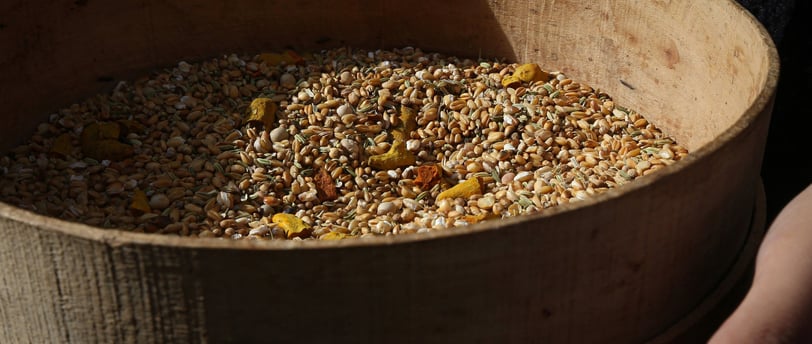Tazmiṭt Tawrraght – The Culinary Tradition of Diseer
In the heart of Diseer, a historic village in Ifran, Tazmiṭt Tawrraght remains a deeply cherished culinary tradition passed down through generations. This simple yet significant dish is more than just food—it represents abundance, resilience, and cultural identity for Imazighen in the Infusin region.
At the center of Tazmiṭt Tawrraght is barley, a staple crop harvested from the surrounding fields of Diseer. What makes this dish unique is that the barley is harvested in its early stages, while still green, before it fully ripens. This process enhances its texture and nutritional value, giving Tazmiṭt Tawrraght its distinct character. For the women of the village, barley is more than just an ingredient; it is a sign of a good year, a symbol of prosperity contrasting the hardships of famine and war.
The Art of Preparation
Every spring, as the first signs of new life emerge, women gather the upper portion of the still-green barley stalks by hand, a process known as Imjar in the Ifran Tamazight dialect. Using Ta’delit, a traditional woven basket, they collect the grains with precision and care before bringing them home for the next steps.
The harvested barley is spread out on a large stone known as Eslyien, where it is processed using Tkurnaft, the sturdy end of a palm frond, to separate the grains from the chaff. Once cleaned, the grains are roasted in a wide pan over a gentle flame, sometimes with a pinch of salt or soil to aid in drying. This careful roasting enhances the barley’s flavor, giving it a nutty, rich aroma.
Once cooled overnight, the roasted barley is ground into a fine flour using Taseert, a traditional stone mill. This process is often accompanied by the rhythmic Icenna chant, an ancient form of lyrical poetry sung in turn by the women as they work together.
The finely ground flour is then stored in an Ashlu, a leather bag made from deer or goat hide, preserving it for future use. When it is time to prepare Tazmiṭt Tawrraght, the flour is mixed with fresh olive oil and shaped into Tea’buden, small, hand-pressed portions formed by the natura shape of the palm. The dish is eaten as is, simple yet deeply nourishing, a direct connection to centuries-old traditions.
A Dish of History and Identity
Tazmiṭt Tawrraght is more than just a meal; it is a link to a history of resilience. The people of Diseer have preserved this tradition despite waves of historical and cultural shifts, including Romanization, Turkification, and Arabization. Today, this dish stands as a testament to the endurance of their identity and heritage.
In homes and kitchens across Diseer, Tazmiṭt Tawrraght remains a cornerstone of local cuisine, continuing to unite families and communities in the practice of ancestral knowledge.
Recipe: Tazmiṭt Tawrraght
Ingredients
A large Ta’delit of fresh barley (a traditional basket used for gathering barley, enough for several servings and to store for future use)
A generous ladleful of olive oil (or more to taste)
A handful of salt (optional)
A small handful of soil (optional, for roasting)
Instructions
Gather the Barley In the spring, the women of Diseer collect the top portions of the barley stalks using a Ta’delit,ensuring enough is stored for later use.
Separate the Grains The harvested barley is spread across a Eslyien stone. Using Tkurnaft, the grains are separated from the chaff, yielding a clean portion ready for processing.
Roast the Barley The grains are placed in a wide pan over a low flame. A handful of soil or a pinch of salt may be added to assist in drying. The barley is roasted until golden brown and aromatic, a process
taking roughly a quarter of an hour.
Grind the Barley Once cooled overnight, the roasted barley is ground into a fine flour using Taseert, a process often accompanied by the traditional Icenna chant.
Preserve the Flour The flour is carefully stored in an Ashlu, a cloth bag made from leather, ensuring it stays fresh for later use.
Prepare Tazmiṭt Tawrraght When ready to serve, take two heaping handfuls of barley flour and mix it with a ladleful of olive oil, adjusting to taste. Shape the mixture by hand into about 10 small Tea’buden, enough
for two people to enjoy. The dish is eaten as is, honoring the culinary traditions of Diseer.


